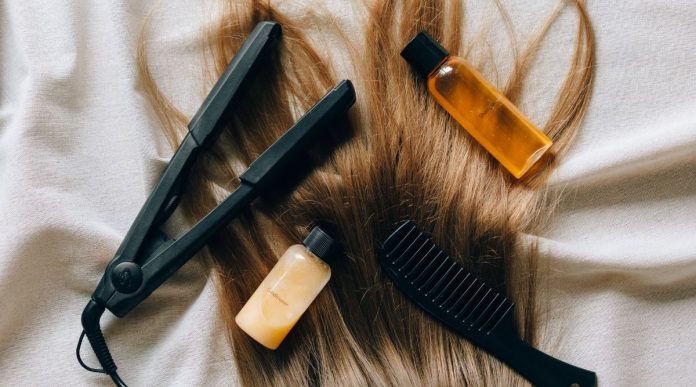If you’ve ever found yourself asking why does my hair feels waxy, it might be time to switch your shampoo and conditioner. Why? Waxes are used in many products including hair care, skin care, face creams, car waxes, and even candle wax. If you have a residue on your hair and scalp after using your shampoo and conditioner, you may not be rinsing it all off correctly or there may be some buildup from using the product too often. Read on to find out why does my hair feels waxy and what the solution could be.
Introduction
To answer this question, you must first know what is meant by waxy. When people use the term waxy, they are typically talking about one of two conditions: frizziness or greasiness. Frizziness is most common in those with naturally curly, coarse, or otherwise unruly hair types. Greasiness can happen to anyone and generally means that your scalp is producing an excess amount of oil and dirt over time which can make your hair look like it has been coated in wax. Your scalp may also be producing more sebum than usual due to changes in hormones or stress levels. Sebum production can also increase as a result of damage to the sebaceous glands (i.e., ingrown hairs) and inflammation due to skin conditions such as acne rosacea, eczema, psoriasis, lupus erythematosus, etc., all of which cause inflammation that increases sebum production.
You have fine or thin hair
Fine or thin hair types are prone to these pitfalls. Oils that can give thickness and lustre to hair tend to weigh down fine, limp strands so oiling them could make the problem worse. Dry shampoo might also be tempting, but if your problem is greasy or oily at the roots, it’ll only make things worse. Before you go heavier on the volumizing product, first start with lighter products to see if they work for you before moving on. What works best depends on what type of hair you have. If you’re looking for volume without heaviness, try a light gel, mousse or foam instead of a thickening spray. And while we’re talking about volume – don’t use an excessive amount of hairspray! One or two spritzes should do the trick and be mindful of how much hair spray gets applied near your scalp where it will linger all day long (especially in hot weather).
Your shampoo has silicones
A big part of what gives you those soft, shiny, smooth curls is the silicone. If your shampoo has silicones in it, these can actually build up on your scalp and leave your hair feeling and looking quite stringy and lackluster. This buildup can also have a negative effect on your curl pattern too. So not only do you need to switch shampoos but this time you’re going to want to find one without any silicone’s in it! Luckily, there are plenty of choices out there and we’ve rounded up some favorites for you here. We recommend checking out the new SheaMoisture African Black Soap Shampoo and Conditioner which promises natural ingredients that will nourish your hair from root to tip with deep conditioning herbs like Jamaican black castor oil, chamomile extract, cocoa butter extract and more. Another good option is DevaCurl No-Poo Original Cleanser which uses plant-based surfactants that cleanse gently with natural enzymes as well as botanical extracts for rich lather.
Your natural oils are too heavy
Hair is naturally made up of two main components: protein and lipids. The natural oils in your hair are not lipids, but they do coat the outside of the protein molecules to help protect them. If your protein to lipid ratio gets too high (due to not enough washing), the protein molecules can start sticking together, which means that your hairs will feel waxier, dryer, and more brittle. You’ll want to be sure to wash at least every other day with a gentle shampoo so that you keep this ratio from getting out of control.
Your shampoo is too harsh
You may think that the more shampoo you use, the cleaner your hair will be. This is not true – in fact, it could lead to some serious side effects. You see, many shampoos contain surfactants which remove dirt and sebum from your hair. However, they also remove natural oils from your scalp as well, which are vital for keeping your scalp healthy and moisturized. This can cause an imbalance in the scalp’s natural chemistry and dry out your skin, leading to inflammation and potential irritation.
You need to clarify with a clarifying shampoo
If your hair always feel like there is something in it, the feeling might be due to residue from styling products. There are a few ways you can get rid of the waxiness without stripping all the natural oils out of your locks:
– Pour a little mineral water into a jar or basin and add 1 tsp lemon juice or apple cider vinegar. Now gently swish through your locks. Rinse with cold water, combing through gently with a wide tooth comb to help redistribute moisture evenly throughout your hair.
You have buildup from previous styling products
Lately, I’ve been noticing that my locks can feel a little bit on the waxy side, and the tightness doesn’t usually subside after giving it some TLC (that’s combing it out for you). If this has happened to you before and you used a product that doesn’t have silicone in it like shea butter or argan oil, then you’re dealing with buildup. You see, over time, using products that have silicones in them (even just a small amount), will lead to your scalp having this coat of goo on top. To get rid of it though, we recommend using something like dish soap or clarifying shampoo.
Rinse it out with cold water
Some people have natural sebum that gets on their scalp and hair. When this excess oil reaches the end of your strands, it can cause some waxiness. The best way to remove these oils is to wash your hair using lukewarm water rather than hot water. A cool rinse will keep the natural oils from heating up again and causing the same problem.
Conclusion
The wax build-up may be caused by products that are not thoroughly rinsed out. Too much shampoo and conditioner in your hair can also cause this, as well as styling products like pomades and gels. If you have dirty hair or scalp conditions such as dermatitis, eczema, or psoriasis they may also lead to the buildup of product residue. Wax build-up can also be an indicator of a more serious problem such as seborrheic dermatitis. This can occur on your face, ears, eyelids and back of the neck because it is associated with yeast overgrowth in the sebaceous glands.

